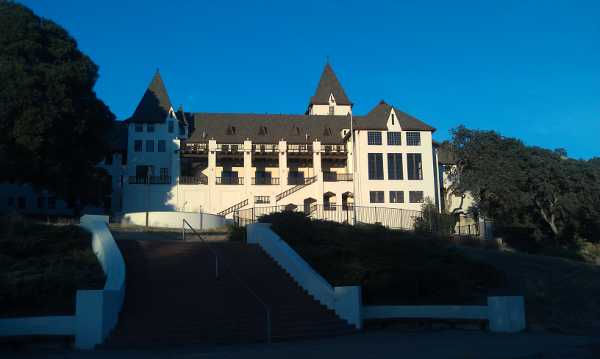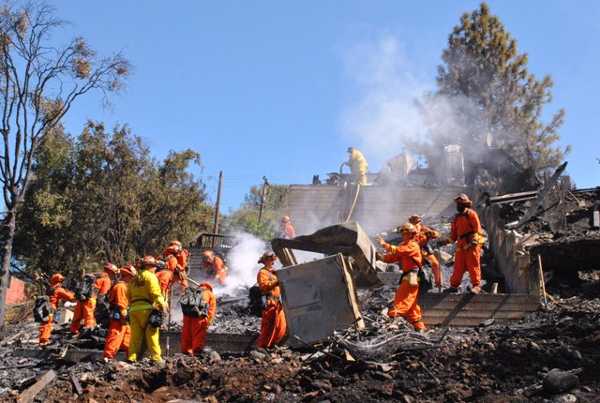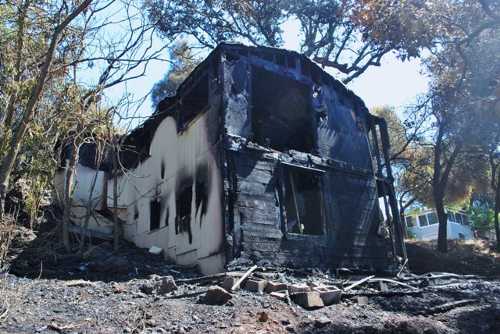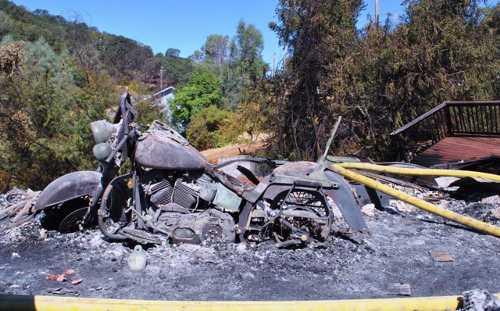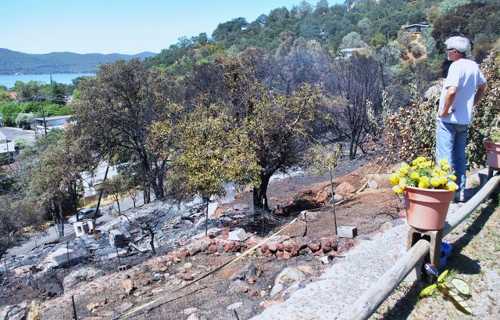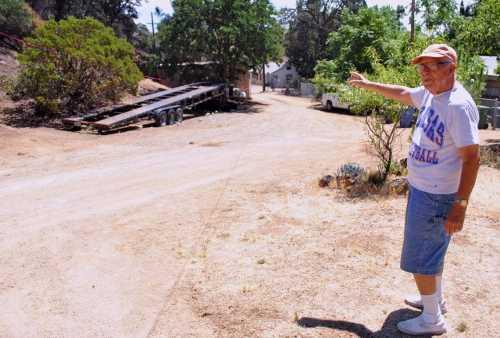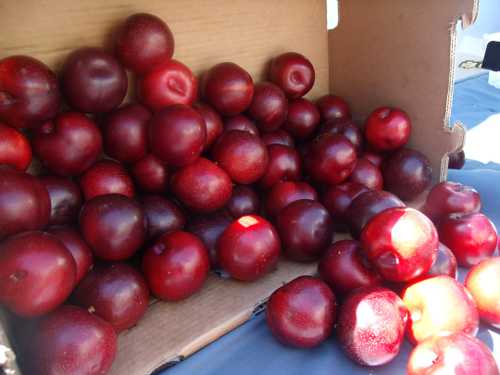
These ripe red plums are available for instant eating out-of-hand at the Lake County Farmers' Finest market on Saturday mornings at Steele Winery in Kelseyville, Calif. Photo by Esther Oertel.
Sometimes life lessons come in the strangest of ways, and my father taught one to my youngest son via juicy summertime plums. Though he was only six or seven at the time, it’s something he remembers still.
We lived in rural Petaluma during the first half of raising our young family. One of the bonuses of our rented property was a prolific Santa Rosa plum tree, one that had been there for decades. Each June, a myriad of reddish-purple orbs appeared on this tree, and it was a race to beat the birds to the succulent fruit.
As my father and older son stood near the tree one summer with stained lips from their hand-picked fare, my younger son watching nearby without indulging. When Dad inquired as to whether he wanted any, Billy replied that he didn’t know if he liked them and wasn’t interested in finding out.
My father said, “Billy, one day you’ll try a plum and then you’ll understand how much time was wasted not eating them.” A short time later Billy became our family’s biggest fan of those Santa Rosa plums.
Plums, not surprisingly, are related to peaches, apricots, cherries, and other “drupes,” i.e., fruits that have a hard stone surrounding their seeds. Dried plums are known as prunes, perhaps harkening back to the scientific name for plum, prunus domestica.
There are six general categories for plums (Japanese, American, Damson, Ornamental, Wild and European/Garden), and their size, shape and color is varied. Plum skin can be as dark as deep blue-black or as light as pale yellow, with a multitude of hues in between, such as red, purple, green and amber.
Most plums are round; however, some are oval or heart-shaped. In addition to the variance in skin coloration, the flesh comes in a rainbow of colors, including yellow, green, pink and orange.
It is thought that plums originated in various parts of the world.
For example, the European plum, discovered more than 2,000 years ago, is thought to have originated near the Caspian Sea and brought to the Mediterranean region by Alexander the Great.
In contrast, the Japanese plum originated in China. The Japanese did much of the cultivation and development of this plum, hence the name.
Early American colonists found wild plums growing along the east coast of the U.S. The Pilgrims introduced European plums to America, which soon replaced native wild plums in popularity and as a commercial crop.
Plums are interwoven throughout human history. The earliest written reference to plums dates back to the time of Confucius, where they were popular in his writings and songs, including a listing of foods popular in China at the time. In ancient Rome, there were already 300 varieties of plums grown in their orchards.
It’s difficult to talk of plums without mentioning plant breeder extraordinaire Luther Burbank, who lived in the late 19th and early 20th centuries. Burbank is responsible for many of the exquisite hybrid plums we now enjoy, including the aforementioned Santa Rosa plum.
He lived in Santa Rosa, Calif., and did most of his work on an 11-acre experimental farm in nearby Sebastopol. There he cross-bred Japanese, American and European plums in the hopes of creating delicious new varieties. He made more than 30,000 crosses of plums, an amazing number, and by the 1920s had released 113 new varieties, some of which are in production today.
Speaking of cross breeding produce, some interesting plum-like fruits have made appearances of late at local farmers’ markets.
Pluots, a cross between plums and apricots, may be found on Saturday mornings at Steele Winery in Kelseyville, Calif., and plurines, the spawn of a marriage between plums and nectarines, at Library Park in Lakeport, Calif. on Wednesday evenings.
The small, blue Damson plum is of ancient origins, hailing from Damascus, Syria. It has a close French relative, the yellow Mirabelle plum. These plums are sour and not good for eating out of hand, but are wonderful when made into preserves, jams and jellies, making them worth seeking out for home canners.
In Victorian times, they were popular when candied, and these were the “visions of sugarplums” that danced in the children’s heads in the poem “Twas the Night Before Christmas.”
Plums are generally available from May through October, and most are delicious eaten as is. When ripe and ready to eat, they should yield to gentle pressure and be slightly soft at the tip.

Pluots, a cross between plums and apricots, are available at the Lake County Farmers' Finest market on Saturday mornings at Steele Winery in Kelseyville, Calif. Photo by Esther Oertel.
If firm when purchased or picked, they’ll ripen at home at room temperature. Avoid plums that are excessively hard, however, as they’ll be immature and will likely not develop a good taste and texture.
Once ripe, store plums in the fridge. Be sure to bring them to room temperature before eating to attain maximum juiciness and sweetness. Plums may be frozen, but pits should be removed before freezing to ensure maximum taste.
To remove the skin for cooking applications, cut a small cross in the bottom of each plum and immerse them in boiling water for 30 seconds or so. Remove them from the water and plunge them into an ice water bath or run them under cold water to stop the cooking process. Once cooled, they should peel easily from the cross on the bottom.
Plums and prunes have wonderfully high stores of antioxidants, and are a very good source of vitamin C. They’re also a good source of vitamin A, vitamin B2, potassium and fiber.
They’re wonderful when paired with wine, as evidenced by the pinot noir-soaked prunes I enjoyed during the Lake County Wine Adventure at Six Sigma Winery in Lower Lake, Calif.
Try poaching plums in red wine or port with a bit of lemon zest for an interesting dessert, make a sauce for ice cream or bread pudding by simmering diced plums in simple syrup, stew plums for a wonderful yogurt topping, or add fresh slices to cereal.
Sliced plums make an interesting topping for pizza when combined with goat cheese and toasted walnuts and flavored with a bit of fresh sage.
If you’re enamored with Chinese plum sauce as I am, you may enjoy today’s recipe for a homemade version of this traditional condiment, compliments of food blog “Dianasaur Dishes” at www.dianasaurdishes.com. I’m a fan of plum sauce on the vegetarian version of mu shu, a Chinese stir-fry served with thin pancakes for wrapping.
Bon appetit! And don’t forget to indulge in beautiful fresh plums while they abound.
Chinese plum sauce from scratch
10-12 small plums
4 cloves garlic, finely chopped
1/4 cup finely chopped red onion
1 tablespoon grated fresh ginger
2 tablespoons soy sauce
1/2 teaspoon red chili sauce
Slice plums in half and discard pits; cut each half into about six chunks.
Mix plums with remaining ingredients in a saucepan and heat on medium low for 20 minutes, stirring occasionally.
Whirl sauce in a blender and add water to thin if desired (usually around 1/2 cup).
Chill to serve.
Store in a jar in the fridge for up to six weeks.
Makes about one cup of sauce.
Esther Oertel, the “Veggie Girl,” is a culinary coach and educator and is passionate about local produce. Oertel teaches culinary classes at Chic Le Chef in Hidden Valley Lake, Calif., and The Kitchen Gallery in Lakeport, Calif., and gives private cooking lessons. She welcomes your questions and comments; e-mail her at This email address is being protected from spambots. You need JavaScript enabled to view it..
Follow Lake County News on Twitter at http://twitter.com/LakeCoNews, on Tumblr at www.lakeconews.tumblr.com, on Facebook at http://www.facebook.com/pages/Lake-County-News/143156775604?ref=mf and on YouTube at http://www.youtube.com/user/LakeCoNews.

 How to resolve AdBlock issue?
How to resolve AdBlock issue? 